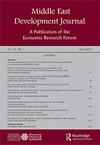Son Preference and Child Under nutrition in the Arab Countries: Is There a Gender Bias against Girls?
IF 0.9
Q4 DEVELOPMENT STUDIES
引用次数: 9
Abstract
ABSTRACT Although son preference has been demonstrated in the MENA region with different manifestations and at several phases of human development, the literature remains sparse as far as studies examining the early childhood phase are concerned. The current study aims to explore the presence of a gender bias in child nutrition status and its association with maternal son preference in three Arab countries; namely, Egypt, Jordan, and Yemen. Child nutritional status is measured using the Height-for-Age z-score (HAZ). To examine the presence of gender bias across the entire nutritional distribution, we utilized a quantile regression framework. We use data from the most recent rounds of the Demographic and Health Survey on a nationally representative sample of children aged 0–4 years. Descriptive statistics show that 21.5% of the mothers demonstrate son preference in Yemen compared to 19.10% in Jordan and 13.26% in Egypt. Results of the baseline OLS model demonstrate a robust pro-girl nutrition bias in the three countries. However, results of the quantile regression model show that this pro-girl nutrition bias is only prevalent at the lower segment of the conditional HAZ distribution for Jordan and Yemen and is prevalent across the whole conditional HAZ distribution for Egypt. We also find no statistically significant association between maternal son preference and gender bias in child nutrition in the three countries. Although son preference is manifested in several phases of human development in the MENA region, the current study finds no nutritional bias against girls in the examined countries at early childhood.阿拉伯国家的重男轻女与儿童营养不良:是否存在对女孩的性别偏见?
摘要尽管在中东和北非地区以及人类发展的几个阶段都有不同表现的重男轻女现象,但就儿童早期阶段的研究而言,文献仍然很少。本研究旨在探讨三个阿拉伯国家儿童营养状况中存在的性别偏见及其与母子偏好的关系;即埃及、约旦和也门。儿童营养状况使用年龄身高z评分(HAZ)进行测量。为了检验整个营养分布中是否存在性别偏见,我们使用了分位数回归框架。我们使用了最近几轮人口与健康调查的数据,该调查针对的是具有全国代表性的0-4岁儿童样本。描述性统计数据显示,也门21.5%的母亲表现出重男轻女的倾向,而约旦和埃及分别为19.10%和13.26%。基线OLS模型的结果表明,这三个国家存在强烈的支持女孩的营养偏见。然而,分位数回归模型的结果表明,这种支持女孩的营养偏差仅在约旦和也门的条件HAZ分布的较低部分普遍存在,在埃及的整个条件HAZ分配中普遍存在。我们还发现,在这三个国家,母子偏好和儿童营养方面的性别偏见之间没有统计学上的显著关联。尽管在中东和北非地区,重男轻女表现在人类发展的几个阶段,但目前的研究发现,在接受调查的国家,儿童早期没有对女孩产生营养偏见。
本文章由计算机程序翻译,如有差异,请以英文原文为准。
求助全文
约1分钟内获得全文
求助全文

 求助内容:
求助内容: 应助结果提醒方式:
应助结果提醒方式:


